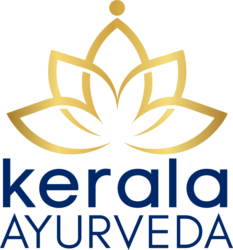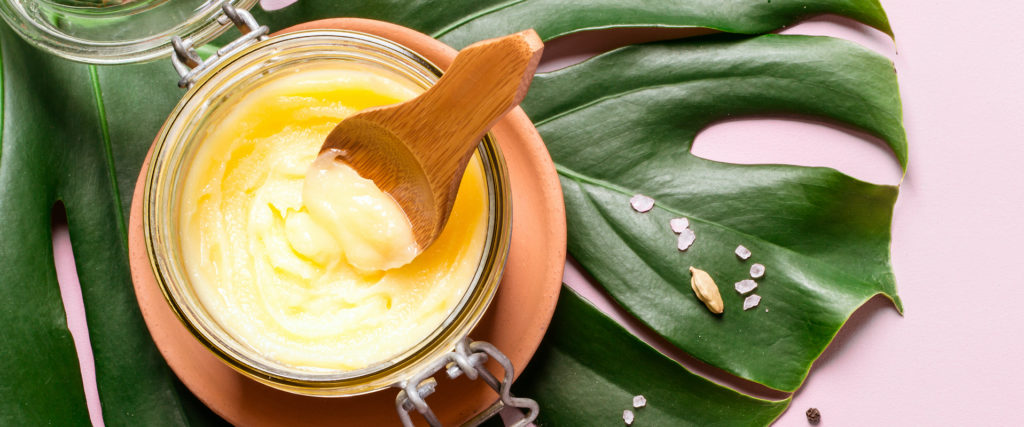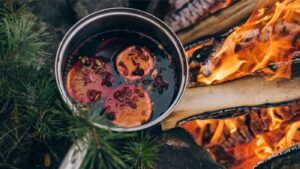Ghee (Ghrta or Ghritam) is cultured, clarified butter (the milk solids and water are removed leaving just the fat). Ayurvedically, ghee is used extensively in cooking and therapeutic applications, both internally and externally. It is the most Ojas or vitality-enhancing substance according to the Charaka Samhita and being Sattvik in nature, improves the clear, blissful state of our body, mind, and spirit. The health benefits of ghee are so versatile that ghee butter, as it is also called, is considered an elixir of liquid gold in Ayurveda!
The history of ghee
Ghee originated in India and has been used there for thousands of years. With portions of the country experiencing intense heat, storing butter for prolonged periods was impossible without spoilage. A way to create stability was needed, so butter was boiled to remove the milk fats and water, leaving only the fat. Ghee was born.
Since Vedic times cows in India have been revered. No cows were forcibly impregnated nor were any calves killed. And only after the calf was satisfied, was leftover milk used. Cultured butter made from such milk was then clarified to produce truly cruelty-free ghee.
Hindu mythology offers a more interesting story for the origination of ghee. The myth centers around Prajapati, Lord of Offspring. According to the story, Lord Prajapati created the first ghee by rubbing or “churning” his hands together. He then sprinkled the ghee into a fire creating his descendants. The story can be interpreted as an enactment of creation with the ghee symbolizing semen and the “churning” the sexual act or formation of the child in the womb.
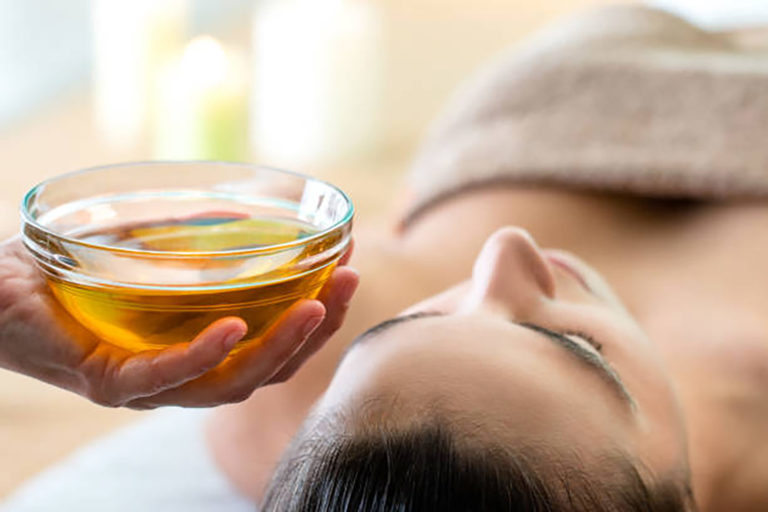
The many health benefits of ghee
There are many benefits of Ghee. It helps kindle all types of Agni (digestive and metabolic fire). Ghee is a very nourishing fat. It penetrates all tissues and is said to cross the blood-brain barrier and has therapeutic properties by itself and in its numerous formulations. It is also Yogavahi (it absorbs and transmits therapeutic properties of herbs to all tissues). Ghee pacifies the Vata and Pitta doshas but can mildly increase Kapha so it is only given in the Nirama stage (when Ama or toxins are digested). But a word of caution, not all ghee is therapeutic, it must be cruelty-free, organic, cultured, and clarified! Additional health benefits of ghee include:
- Nourishing, strengthening, immunity building, and rejuvenating, Ghee nourishes and protects all the tissues starting with the Rasa Dhatu. Ghee is the single most Ojas-enhancing substance and is considered an anti-aging tonic that rejuvenates and promotes longevity.
- Aides in digestion by kindling Agni and supporting enhanced nutrient absorption.
- Provides lubrication internally and externally. Ghee improves luster, enhances complexion, reduces dry skin, dry colon, and stiffness in joints.
- Ghee is Yogavahi or the best medium for delivering Ayurvedic formulations as it assumes their characteristics and ensures they penetrate all tissues. It is a good Anupaan (medium) for many Pitta/Vata formulations.
- Improves eyesight, strengthens sense organs, and voice clarity.
- It is good for mental health conditions, and improves brain health, concentration, cognitive function, intelligence, and memory.
- Enhances the reproductive tissue and improves libido.
- Ghee is anti-inflammatory and rich in linoleic acid, Vitamins (A, K2, and E), and Omega-3 fatty acids. And it’s a source of butyrate acid, a short-chain fatty acid that promotes gut health.
- Aids in cleansing and detoxification at a physical and mental level. Ghee penetrates every Dhatu (tissue), loosens and binds with toxins, and brings them to the gut for elimination.
- Heals the gut and supports the liver, heart, and kidneys.
- Promotes healing of wounds, traumatic injuries, and skin infections.
- Relieves burning in the skin and is used after Kshar Karma, a para-surgical procedure with significant efficacy in managing piles and fistulas.
- Ghee is good for pregnant and lactating mothers.
- Promotes healthy elimination and when added to milk can help relieve constipation.
- Ghee is fattening and can aid in degenerative conditions and emaciation.
Contraindications - when ghee should not be used
During the Ghee making process all casein, whey, and lactose should be removed but in the case of those with dairy allergies, Ghee consumption is advised against as a precautionary measure. Additionally, Ghee should not be consumed by those following a vegan diet, individuals with unbalanced Kapha or Ama (except for Shatpala Ghritam), hepatitis, fatty liver, congestion, fever, obesity, indigestion, and/or diarrhea.
Ghee for detoxification and Ayurvedic applications
Ghee is sweet, cooling and pacifies Vata and Pitta. It can be recommended in food, therapeutically by itself, in formulations, or as an Anupaan (medium in which formulations are given). It is often used during cleansing and detoxification and various other Ayurvedic therapies.
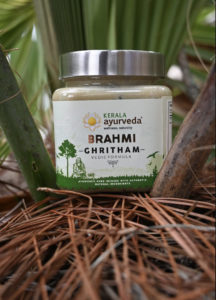
Herbal formulations/Ghritams
Medicated Ghritams are best for internal oleation, rejuvenation, and addressing many imbalances. They are used for oral intake, Vasti (medicated enemas), or for numerous other therapies.
Ghee can be given based on an assessment of Agni and imbalances (ie. Dadimadi Ghritam) and the usual dosage is 1-2 tsp(s) at bedtime or early morning. An example of a therapeutic Ghee is Indukāntha Ghritam (Ref: Sahasrayogam). This is indicated in Vāta disorders, degenerative disorders, ascites, spasms, gastritis, duodenitis, intermittent fevers, and for enhancing immunity.
Many Ghritams are also used in neurological and psychiatric disorders and for enhancing mental health like Saraswatha Ghritam, Kalyanaka Ghritam, Lasunadi Ghritam, and Brahmi Ghritam. Examples of these Ghritam formulations include Mahatiktakam Ghritam, Sukumara Ghritam, and Panchatiktakam Ghritam. These can be used in Shamana (as formulations to correct imbalances, along with dietary and lifestyle suggestions) or in Shodhana (cleansing modalities).
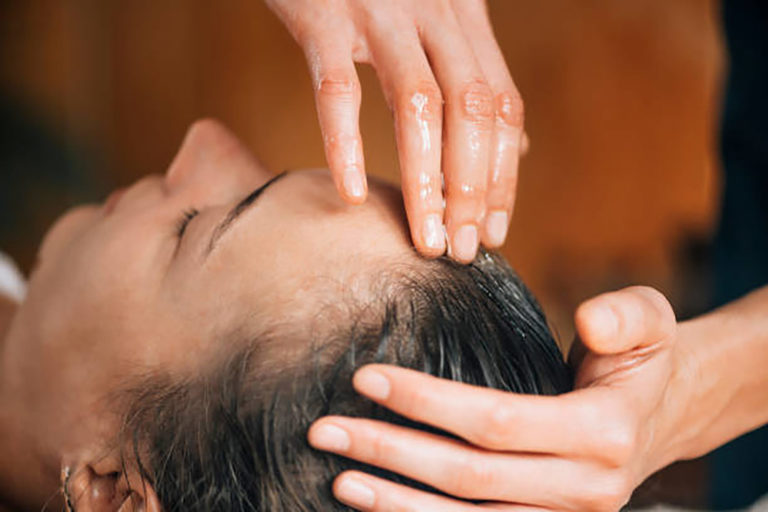
Snehapana: Use of Ghee for cleansing and detoxification
Ghritams can be used in Panchakarma or seasonal cleanses. Ghee ingested during the Snehapana phase of cleansing dissolves and digests Ama at the tissue level and carries wastes to the Koshta or intestinal tract to be expelled.
In seasonal cleanses, the supervising Vaidya assesses every client through personalized consultation and determines their current imbalances. All their formulations, including the Ghritam to be given during the cleanse, are decided based on this assessment. During a cleanse increasing amounts of Ghritam are given over a 3-, 5- or 7-day period. The quantity of Ghritam to be taken and its impact is monitored daily.
Ghee uses for Ayurvedic therapies
Ghee is also used for Pratimarsha or daily Nasya. Typically, two drops of lukewarm, melted Ghee are applied in the nostrils in the morning. This can be done as part of Dinacharya or one’s daily regimen, or therapeutically under the guidance of a Vaidya. Additional therapeutic uses include use in oil pulling, herbal smoking, and as a lubricant in the case of rectal suppositories.
Netravasti or Netra tarpana is an Ayurvedic therapy used in multiple eye disorders. A dam is created with flour and filled with a Ghritam (Triphala Ghritam is commonly used). It is a specialized procedure for eye health that should be done under the guidance of a qualified Ayurvedic professional.
Ghee can also be used for Vasti (medicated enema) in a personalized cleanse. Vasti is known as ‘Ardha Chikitsa’ or equal to the worth of half of all Ayurvedic treatments because of how valuable they are in helping with many imbalances of all Doshas, primarily Vata.
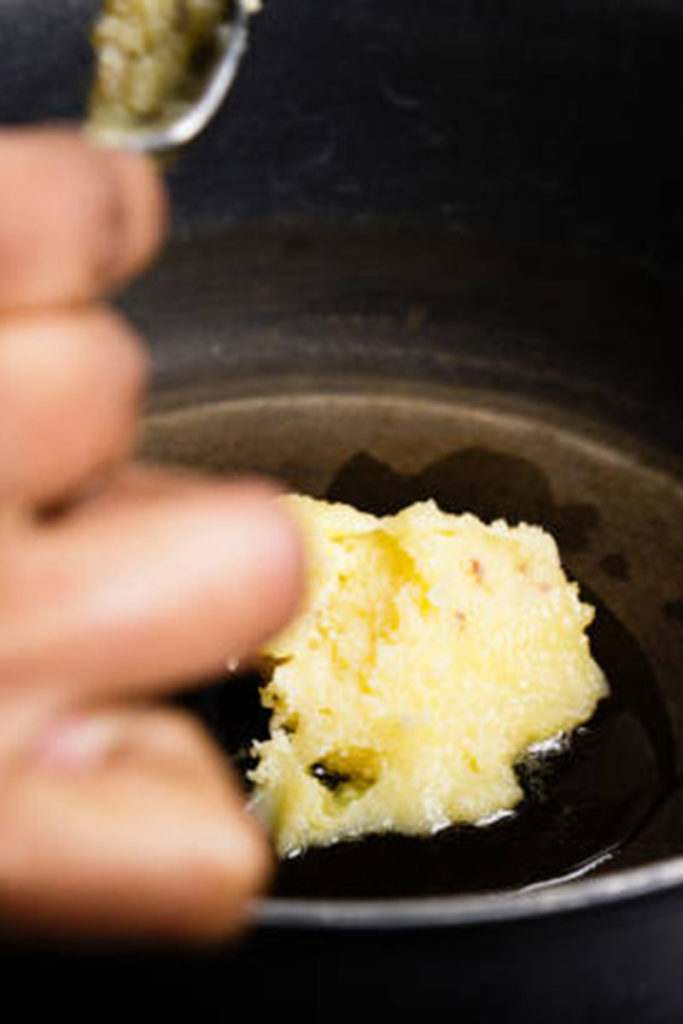
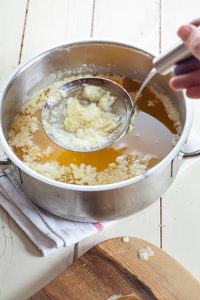
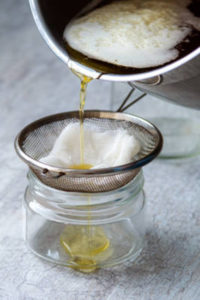
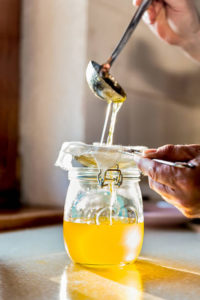
Cooking with ghee
The aroma of clarified butter or Ghee butter wafts through many Indian kitchens! It is used extensively in cooking due to its high smoke point. Ghee or ghee combined with spices, like Turmeric Ghee, adds taste and flavor to all food, from rice pulaos to lentils to vegetables. It enhances the benefits of herbs and spices and aids their absorption. And it’s easy to make.
How to make Ghee: Start with unsalted, cultured butter (homemade or store-bought). Heat the butter, uncovered, at medium heat until it melts. Cook for another 10-15 minutes at low to medium heat as it gently boils and bubbles. You will notice the milk solids begin to separate and turn orange or light brown as they sink to the bottom of the pan. Watch closely so that it does not burn. Once the crackling sound subsides and melted butter foams with a beautiful golden color, remove from the heat and let cool. Strain the Ghee through a cheesecloth or sieve into an airtight, glass container.
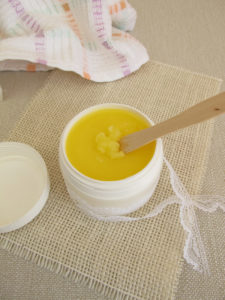
Ghee, liquid gold for the skin
You can reap the benefits of Ghee on the skin by applying it topically or ingesting it (Thikthaka Ghritam helps optimize skin from within)! Here are a few of the many benefits for your skin.
- Moisturizes the skin, gives it a glow and luster and is excellent for use in abhyanga or self-massage.
- Ghee can be used in face packs or for spot treatments and helps with dark spots and dark circles under the eyes.
- Heals minor wounds and is great for chapped skin, lips, and dry elbows and heels.
- With its antioxidant properties, Ghee helps deliver nutrients to the skin, hair, and scalp.
- Formulations like Shata Dhauta Ghritam can moisturize and heal burns, herpes, mild burning in the anus, and chicken pox scars.
- For pregnant women, ghee is applied below the umbilicus if there is bleeding and can be applied to soothe cracked nipples in lactating women.
Ghee: A legacy, not a Fad
From cooking to cosmetic and religious applications to deeply therapeutic ones, Ghee has so many benefits it’s impossible to list them all! You can add it to your latte, apply it on your toast or smear it on your face. Ghee is a vital, staple part of the Vedic legacy. No wonder it’s considered the golden elixir of Ayurveda!

References:
- (PDF) Ghee: Its Properties, Importance, and Health Benefits (researchgate.net)
- (PDF) Shata – Dhauta – Ghrita – A Case Study (researchgate.net)
- Ghee Benefits for Skin: 9 Ways to Soothe Skin Woes (healthline.com)
- (PDF) A Review Paper: Current Knowledge of Ghee and Related Products (researchgate.net)
- Ashtanga Hridayam 8/43, 9/27, 10/22, 29/36 (also chapter 5), Charaka Samhita 25/40
- https://www.healthline.com/nutrition/ghee#Benefits-of-ghee
- List of WebMD’s research – https://www.webmd.com/diet/ghee-good-for-you
- AYU: An International Quarterly Journal of Research in Ayurveda: “The effect of ghee (clarified butter) on serum lipid levels and microsomal lipid peroxidation.”
- ESHA Research, Inc., Salem, Oregon: “Ghee.”
- The FASEB Journal: “Anti-inflammatory effects of sodium butyrate on human monocytes: potent inhibition of IL-12 and up-regulation of IL-10 production.”
- International Journal of Obesity: “The role of conjugated linoleic acid in reducing body fat and preventing holiday weight gain.”
- Journal of the Academy of Nutrition and Dietetics: “Dietary fat increases vitamin D-3 absorption.”
- Journal of Complementary and Integrative Medicine: “Beneficial effect of ghee consumption over mustard oil on lipid profile: A study in North Indian adult population.”
- The Yoga of Herbs: An Ayurvedic Guide to Herbal Medicine: David Frawley, Vasant Lad: 9780941524247: Amazon.com: Books
- Effects of dietary supplementation with ghee, hydrogenated oil, or olive oil on lipid profile and fatty streak formation in rabbits – PubMed (nih.gov)
- Effects of cow ghee (clarified butter oil) & soybean oil on carcinogen-metabolizing enzymes in rats – PubMed (nih.gov)
- Ghee and honey dressing for infected wounds – PubMed (nih.gov)
- Effect of hydrogenated, liquid, and ghee oils on serum lipids profile – PubMed (nih.gov)
